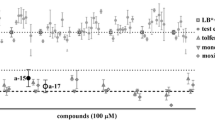Abstract
Approximately 60% of fourth-stage larvae ofNematospiroides dubius recovered from mice 6 days after infection, developed to the young adult stage when cultured over a 7-day period in a complex medium in vitro. Larvae at the late fourth stage of development were found to be highly susceptible to most broad spectrum anthelmintics under in vitro conditions, the benzimidazole, imidazothiazole, pyrimidine, isothiocyanate and macrocyclic lactone compounds all being active at very low concentrations. Narrow spectrum anthelmintics active only against ascarids, pinworms, filariae, cestodes or trematodes had little or no effect on these larvae. Ineffective also were those chlorinated hydrocarbon, substituted phenol and salicylanilide compounds known to affectHaemonchus but not trichostrongylid worms in general. It is concluded that in vitro assays employing larvae ofN. dubius are useful for the stringent screening of compounds for broad spectrum antitrichostrongyle activity. Used in conjunction with in vivo screens employingN. dubius in mice, they also afford means for detecting intrinsic activity against the parasite in a system free from any complicating host pharmacokinetics.
Similar content being viewed by others
References
Coles GC, McNeillie RM (1977) The response of nematodesin vivo andin vitro to some anthelmintics. J Helminthol 51:323–326
Ey PL, Prowse SJ, Jenkin CR (1981)Heligmosomoides polygyrus: simple recovery of post-infective larvae from mouse intestines. Exp Parasitol 522:69–76
Jenkins DC (1982)In vitro screening tests for anthelmintics. In: Owen D (ed) Animal models in parasitology. MRC Symposium, Macmillan, London, pp 173–186
Jenkins DC, Carrington TS (1982) Anin vitro screen for anthelmintics employingNippostrongylus brasiliensis in a defined medium. Vet Parasitol 11:223–230
Jenkins DC, Rapson EB (1983) Development ofTrichostrongylus colubriformis in vitro (abstract). Parasitology 87:1xxi
Jenkins DC, Armitage R, Carrington TS (1980) A new primary screening test for anthelmintics utilizing the parasitic stages ofNippostrongylus brasiliensis in vitro. Z Parasitenkd 63:261–269
Pritchard RK (1978) In: Donald AD, Southcott WH, Dineen JK (eds) The epidemiology and control of gastrointestinal parasites of sheep in Australia. CSIRO, Melbourne, pp 76–107
Rapson EB, Jenkins DC (1983)Trichostrongylus colubriformis in vitro: a novel screen for anthelmintics (abstract). Parasitology 87:xxvii
Standen OD (1963) Chemotherapy of helminthic infections. In: Hawking F, Schnitzer RJ (eds) Experimental chemotherapy, vol 1. Academic Press, London, pp 701–892
Whitlock JH (1945) Anthelmintic bioassay of simple saturated hydrocarbons. Cornell Vet 35:214–220
Author information
Authors and Affiliations
Rights and permissions
About this article
Cite this article
Jenkins, D.C., Ibarra, O.F. Nematospiroides dubius: response of the late fourth-stage larva to anthelmintics in vitro. Z. Parasitenkd. 70, 395–402 (1984). https://doi.org/10.1007/BF00927827
Accepted:
Issue Date:
DOI: https://doi.org/10.1007/BF00927827




